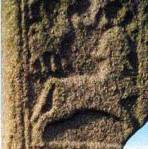
Pictish Maiden Stone on Bennachie: its Christian side faces west
Aberdeenshire is famed for its Pictish symbol stones thought to date from at least the 5th century, the earliest found in profusion on fertile farmland of a busy agricultural society, saved from destruction by gunpowder or the plough by deep-seated superstition.
Within an oral culture handed down from ancestral times, it didn’t do to harm the stones. They were, after all, one of few remnants of the country (‘pagan’ from Latin paganus, countryman) tradition which predated Christianity, of which the ancestors spoke.
Parishes of Northeast Scotland in the farflung reaches of Aberdeenshire, Banffshire and Moray followed the instruction of the Reformed Church to the letter – while at the same time managing to guard handed-down veneration of ancestral places. This apparent anomaly has resulted in the survival of around 600 Neolithic recumbent stone circles in the northeast triangle, and though separated by 3500 years, roughly 100 Pictish symbol stones.
In academia Pictish stones are divided into Class I, inscribed; Class II, relief-carved cross-slabs; Class III relief with horsemen, kings, hierarchical designs; and Class IV, cross-stones with no other ornamentation. The earliest Class I and Class II stones are invariably found in association with pre-Christian sacred sites.
Throughout the early years of Christianity in this far-northern corner of the former Pictish kingdom, sacred sites were in no immediate danger. Pope Gregory I in AD596 sent (through Augustine) the instruction:
“By no means destroy the temples
of the idols belonging to the British, but only the idols which are found in them; inasmuch as they are well-constructed, it is necessary that they should be converted from the dowership of demons to the true God.”
A century after Augustine, however, more extreme measures were called for: in Theodore’s Penitential, AD690,
“idolatry, worship of demons, cult of the dead, worship of nature, Pagan calendar customs and festivals, witchcraft and sorcery, augury and divination and astrology”
were banned. Yet the old ways persisted.
Megalithic structures such as the Aberdeenshire recumbent circles survived. In the words of one 18th-century Northeast clergyman:
“superstition spares them though stones are so scarce”

Pictish symbols on Carved 'Class I' stones date from AD5thC
Pictish stones did not fare so well.
Ultimately their portability became their downfall. While superstition had spared them until the onslaught of a Victorian gentlemanly pursuit – antiquarianism – from that point on they were coveted, uprooted, “taken in” and “protected” all over the place. The Church, of course, had first priority because by “taking them in” (installing in graveyards, building into the fabric of hallowed structures, or reusing as family tombs) they were simultaneously being de-paganized and infinitely gently being nudged under the Christian umbrella.
Class I stones
Beautiful examples of these Pictish pre-Christian sacred markers – carved with animal and geometric symbols in a style standardized throughout the Kingdom (image, top) – stand within kirk precincts today at Banffshire churches of Mortlach, Marnoch and Ruthven, in Moray at Advie, Birnie, Inverallan, Inveravon, and Knockando, and in Aberdeenshire at Clatt, Rhynie, Tyrie, Fetterangus, Dyce, Deer, Fyvie, Kinellar, Kintore, Bourtie and Inverurie. They are usually rough-hewn, from boulders or glacial outcrops.
Class II stones,

Migvie Pictish cross stone with curling terminals in kirkyard at Migvie, Tarland, Aberdeenshire
Sculpted into ‘dressed’ blocks, and dating from after
King Nechtan’s (706-729) campaign of Chrstianizing his Kingdom: usually a cross-shaft sharing space with animal ‘spirits’, familiar to the pre-Christian population: these can be found in St. Mary’s Monymusk, Migvie, Logie-Coldstone, Tullich-Deeside, Fordoun-Auchenblae (the Mearns), Elgin cathedral.
Local lairds also had their fair share of the spoils. In the rush to comply with post-Reformation instruction to build new churches, often on pagan sites, stones were broken up for building, reused in threshing floors or as millstones, or taken to form a decorative feature at the laird’s house.
National Trust for Scotland‘s Leith Hall and Brodie Castle are custodians of three, open to the public. Others, at Newton House, Arndilly, Keith Hall, Castle Forbes, Park House, Logie House, Mounie Castle, Craigmyle House, Tillypronie Lodge, Knockespock House, Blackhills House, Whitestones House and Whitehills are in private ownership and are not accessible to visit, except by appointment.

Nether Corskie, Dunecht Pictish symbols carved on stone circle stone
Five known Class I stones in Aberdeenshire still stand in their original sites:
Ardlair, Kennethmont; Nether Corskie, Dunecht; the Insch Picardy Stone at Whitemyres Farm; Brandsbutt in a housing estate in Inverurie (re-constituted after 19thC blasting) and the Rhynie Craw Stane.
Moray Class I stones thought to be in situ stand at Congash (2) and Upper Manbeen.
The rest, totalling an unknown figure (32 recorded), abound in museums round the Northeast, are in Edinburgh or are considered “lost”.
Upwards of 30 carved sacred water-bull stones were, in oral tradition, said to form a ‘spirit’-guarded wall or protective precinct round the Pictish port-stronghold of Burghead (Latin. Tarvedunum, dun, fort of the bulls) which juts out from the mainland into the Moray Firth between Forres and Elgin.
All but six of these sacred bulls were destroyed or thrown into the harbour in early 19th-century reconstruction of the town.
Ironically Burghead is one of the most ardent communities in keeping Pictish tradition, celebrating the sun’s return after winter solstice by “Burning the Clavie” – a man-size torch carried sun-wise round the town on the shoulders of the clavie king and his crew on January 11th each year.
Sueno’s Stone, Forres (Class III with cross but no Pictish symbols – instead panels depicting a saga of the Scots’ victory over the Picts) was re-erected, possibly the wrong way around after being found buried deep in sandy Moray soil. It now stands in a glass-covered protective shield.
Clusters of Pictish symbol stones found embedded in mediaeval mounds at Kintore, Tyrie and Drumblade, buried face-down at river confluences (Donaldstonehaugh, River Isla) or close to Pictish villages (Aikey Brae and Rhynie Barflat) have disappeared.
A Class I stone carved with horseshoe on an earlier stone circle stone was rescued from oblivion in the 19th-century erection of a memorial to the Duke of Lennox and returned to Huntly Market Square, to share honour with the Marquis.

Dessicated & desecrated: Rhynie Man in vestibule of government offices Aberdeen
Another, carved on a circle stone near Dunecht, was only discovered after a horse with “mange” rubbed himself on the stone and the farmer, fearing spread of the affliction, wiped the stone with lime, revealing long-lost symbols.
As late as 1978 and 1983 symbol stones from Barflat (Rhynie “Man”) and Insch (Wantonwells) were removed from their original location as archaeological prizes: Wantonwells went to Aberdeen’s Marischal Museum where it is climate-controlled, but Rhynie Man stands in the vestibule of Woodhill House, local government office headquarters and a prize possession as blatant as any claimed by19th century “gentleman-archaeologists”.
Into this climate of haphazard care, the Maiden Stone interjects herself. One of only four Class II stones in Aberdeenshire, she might have been carried off as a prize, but, perhaps because of her legendary character, she has survived. Earliest remnant of a pre-Christian myth is a wonderfully-confused tale that she was the maid of Drumdurno, turned to stone by the spirit of the mountain (Jock of Bennachie, Sc.Gael. diadhachd pron.Jahck = a god) when she prayed to be rescued from pursuit by the ‘devil’ who had bargained with her that he could build a causeway up Bennachie (prehistoric Maiden causeway) before she could finish baking her firlot of bannocks (scones).
Another story, more likely to be based on fact, is that she was the daughter of the laird of Balquhain who was killed by accident after eloping with the son of a rival laird.
Third, that she was one of several maiden conquests of a Leslie laird who dragged his prey to the “fort” (Iron Age enclosure on Mither Tap) of Bennachie where he had his way with them! Fate saw to it that he died at the battle of Harlaw, 1411.
All four surfaces, broad East and West faces and narrow sides, are decorated. The pagan side, facing east, depicts four panels each featuring symbols used in earlier Class I stones, but with typically late carving in relief. Gouged out of coarse-grained pink Bennachie granite, this was no mean feat, but the technique allows animal and geometric forms to stand out clearly in low raking sunlight, even after 1100 years. The west face is dominated by an interlaced wheel cross, underpinned by a circular spiral-filled design with key pattern and knotwork, while overhead are mounted two ketos or fish, gently cradling a clerical figure. This “Christian” face is badly weathered.
The Maiden stone is virtually unique: it has a combination of sacred Pictish symbols covering one whole side, while also dominating part of the invading Christian side. If its dating is correct to post-AD843, after the Scots finally obliterated the kingdom of the Picts in this Northeast corner, the inner sanctum of a vanquished race, it was perhaps politic to share religions.
Sueno’s Stone at Forres, closer to Burghead, the last Pictish stronghold to hold out against the enemy, is more warlike in proclaiming its Christian message of ‘Right is Might’, and it, too, shows a central figure supported by two curving (fish?)shapes on the Christian side, below the cross.
On all other known Class II cross-slabs in Northeast Scotland, In fact, where sacred symbols of the two faiths share space (Monymusk, Fordoun, Migvie, Mortlach, Dyce) the cross occurs on the same face as Pictish animal and geometric symbols.
Invading Scots perhaps had the presence of mind never to carve in the Northeast free-standing crosses such as those other blatant examples of their dominion: the High Crosses of Iona and western Scotland.
 The closest to a western motif found in the East is the Loch Kinord cross-slab at Cromar, but even its curly-terminal cross is trapped within the oval of the stone, in the northern Pictish tradition. Farther south within Angus/Forfar and Perthshire/Fife a clear dominance by warlike Scots results in a multitude of “Class III” stones, sometimes so-called because they feature crosses and horsemen, but few Pictish symbols. It is an historic fact that central Scotland succumbed to Scots rule long before the Men of Moray who held out culturally until Macbeth (died 1057).
The closest to a western motif found in the East is the Loch Kinord cross-slab at Cromar, but even its curly-terminal cross is trapped within the oval of the stone, in the northern Pictish tradition. Farther south within Angus/Forfar and Perthshire/Fife a clear dominance by warlike Scots results in a multitude of “Class III” stones, sometimes so-called because they feature crosses and horsemen, but few Pictish symbols. It is an historic fact that central Scotland succumbed to Scots rule long before the Men of Moray who held out culturally until Macbeth (died 1057).
So it may be that the Scots who influenced the carving of the late Pictish Maiden Stone had to bow to the strength of a prevailing worship of nature spirits in order to get their message across.

Salmon and Pictish 'cauldron' on Class I stone at Kintore
It is now generally accepted that the Picts had their own water cult and that the salmon, dolphin and other great fish (Gk.
ketos) were central to that worship. Roman historians were aghast when discovering that Picts ate no salmon, though their rivers were teeming with them. Flesh of the goose, too, (Roseisle Class I stone in Edinburgh) was never eaten, though they roamed wild in profusion. The dolphin (or Pictish “beast” carved on 24 Class I stones in east Scotland) was believed to be sacred because it could live both in air and water and shared knowledge of the world beyond the sunset. The salmon was sacred; it also lived in two media – saltwater and fresh – sharing its knowledge of the seven springs of wisdom. References to sacred salmon kept in wells occur as late as the 16th century, usually by the priest or the minister, who by then was supposed to be as learned as they.
‘A well . . . at which are the hazels of inspiration and wisdom, the hazels of the science of poetry and, in the
same hour their fruit and their blossom and their foliage break forth, and these fall on the well in the same shower, which raises on the water a royal surge of purple. Then the sacred salmon chew the fruit and the juice of the nuts shows on their red bellies. And seven streams of wisdom spring forth.’
Stokes translation 1887, Old Celtic Legend.
All Pictish Class I stones in Northeast Scotland whose original location is known were placed within a mile of water.
Would it not then be wise to enlist the support of this great spirit of the water when proclaiming a new faith to a Pictish audience?
The fish on top of the cross on the Maiden stone may not only be supporting the little cleric, new at his job, but whispering their knowledge in his ear. On the eastern (‘pagan’) side, it is probably significant that the four panels depict the highest order of Pictish symbolism, even if adapted in late relief form: at the top a panel shows animals of the forest, but one has the ability to shape-shift to part-human.

Shapeshifting Centaur? on Maiden stone's east face
Shape-shifting was legendary among the Picts and incoming clerics made use of this belief to convert, even using shape-shifting themselves (according to tradition) to show the potency of the new faith. Columba was known to encourage belief in his ability to shape-shift, raise and still storms and produce wine from water in order to convince his new flock.

Fire Altar and Lightning rod on Maiden Stone's east face
Panel two shows the great Z-rod and fire altar used in the four annual fire festivals at the doorway to the seasons – Samhain, Oimelc, Beltane and Lughnasadh. Interestingly, Burghead’s fire-altar the “Doorie”, into which the flaming mass of burning creosote, tar and oak staves is thrust as a final gesture in Burning the Clavie, is similar in shape. The Z-rod, thought to symbolise the magic of lightning or a celestial wand, occurs in tandem with fire-altars, serpents, double-sun symbols in a majority of Northeast symbol stones.

Relief-carved sacred Dolphin on Maiden Stone's east face
Panel three holds the sacred dolphin, carved without companions or embellishment – alone in his supreme position as carrier of great knowledge.

Maiden Stone Order of the Feminine: matrilineal symbols mirror and comb
Panel four bears the female symbols of mirror and comb, probably the oldest symbolism of all, of the goddess, the earth herself, but by early Scots times diminished into a lower order. The Picts had a matrilineal system of succession, but this and all it signified was forceably suppressed in the Scots order of male rule. Though Macbeth claimed the throne by tanistry (the Pictish right by blood through the female line which enabled brothers to succeed brothers or uncles, but not sons to succeed fathers) he was last to lose to the Scots system which prevailed.
Etymology plays a part in the jigsaw of piecing together the Maiden’s meaning. Gael. Maoid-hean means prayer, entreaty, supplication. If it was used as a place of prayer, as records show many Pictish stones were, it was a habit capitalised on by early clerics in their conversions. Stones around Aberdeenshire named for saints include Marnan’s chair, a megalith in St Marnoch’s churchyard, and Brandan Stanes recumbent circle, both Banffshire; three symbol stones ogham-inscribed to indicate “Eddernan” or St. Ethernan preached at each; and Clochmaloo or the stone of Moluag, patron saint of inland Aberdeenshire, a glacial erratic perched on a slope of Tap o’ Noth topped by a huge five-acre vitrified fort. Also Mâg (plain, pron. mai)-dun means a fort commanding an open plain.
The astronomers may have the last word: Scots-Gaelic Madiunn means morning; the morning sun rises to shine on on the pagan eastern face of the stone until precisely midday, when it casts no shadow on either face.
Meadhon means mid or centre, either denoting the centre of a powerful area, which the fertile Garioch plain most certainly was, its nickname ‘Girnal” (grainstore) of Aberdeenshire handed down for generations; or it could mean mid in a time sense. As noon approaches on any clear day, but spring and autumn give better angular light, the sun which has shone directly at the symbols all morning begins to pick out the gentle curves and cast the tiniest of shadows along the bodies of pagan beast and mystic wand. Shadows lengthen until at noon they completely fill the space of the recessed background from which the symbols spring in relief – almost as if filling a pool.
At noon, the sun casts no shadow either on pagan or Christian side – just a brief gnomon-like shade in the short grass. Then as the minutes tick by after noon, shadows appear to fill the spaces on the Christian side and form pools in the four sockets of the wheel cross gradually shortening over the bodies of the giant fish, until around 12:10 p.m. when shadows are once again imperceptible. As a noon sundial, the Maiden is unbeatable.
Local support for leaving the Maiden Stone untouched was strong, though if the decision had gone the other way, few would have stood up and caused a revolution. It is because the decision has been made in favour of her native setting, hovering over the Water of Crowmallie, that future generations may be able to share the Maiden’s knowledge which was originally shouted in a loud voice from the slopes of Bennachie. Only we, her children, have forgotten the meaning of the words. It is up to us now to remember the ways of the natural world, and to take into ourselves the messages left by a culture which may have much to teach us.
©1996-2009 Marian Youngblood


























































Recent Comments